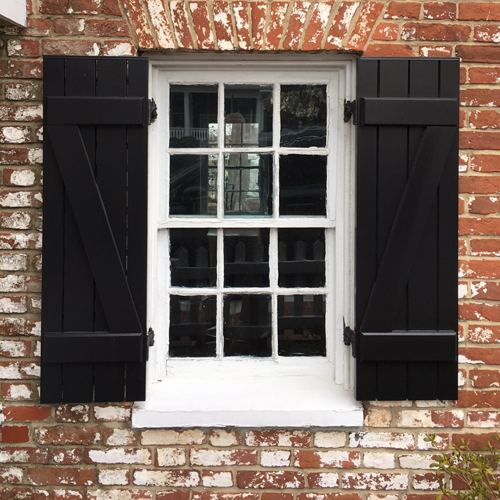
On Instagram I am known as the shutter guy because of my #ShudderSunday posts where I show poor execution of shutters. I love wood shutters so very much and it pains me to see how many times they are installed improperly.
Shutters are not only one of the most beautiful architectural elements you can add, if done appropriately, but they are also extremely functional to protect your windows and keep your old home cool in the summer or warm in the winter.
In this post, I’m going to teach you everything I know about shutters. That’s right. This a long post, but it will be packed with invaluable information and organized so that whenever you have a question about shutters you can come back and find it right here.
The History of Wood Shutters
Shutters have been around since antiquity. Before there was glass in windows (only the wealthy could afford glass) there were shutters covering simple openings in a wall. These historical shutters could be closed during inclement weather and opened and again when weather was pleasant.
It’s simple if you think about it since the first windows functioned like doors. You would swing open the shutters when you wanted fresh air and close them when you wanted to keep bugs and weather out.
Louvers were an early addition to allow some airflow especially when cooking but to still keep the rain out when the shutters were closed. In these early years airflow was an important part of shutter design, much less than today where the window controls airflow mainly.
Wood Shutter Styles
Just like the different architectural styles of houses they grace, shutters come in all different styles and designs. The options are really endless, but there are certain definitive styles, and I’ll cover those here. The small differences are like variations on a theme not unlike the multitude of options on a car.
Louvered Shutters
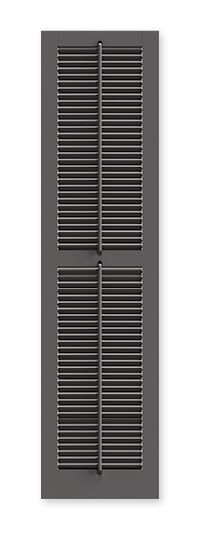
Timberlane.com
Possibly the most popular and common style of shutter is the louvered shutter. This style is most common on architectural styles like Cape Cod, Colonial Revival, Greek Revival, Folk Victorian, Queen Anne, Italianate, Georgian & Adam.
Louvered shutters come in a few different variations. For example, you may have two or even tree panels of louvers with a middle rail dividing them or you may have one full panel of louvers.
It’s also not uncommon to find these shutters with a flat panel at the top or bottom 1/3 of the shutter. The top portion would occasionally have cutout designs (we’ll discuss these shortly) on Colonial Revival homes.
Operable Louvers
In addition to the variations above you may also have operable louvers on your shutters that allow you to control light and airflow through the shutter.
These are made apparent with the presence of a tilt rod and “mouse” cut into the shutter frame to fit the tilt rod when closed.
These shutters have a lot of moving parts and can cost significantly more to make and to maintain, but the flexibility of them is unmatched.
Inoperable Louvers
The simpler version of a louvered shutter is one that has the louvered fit into the frame of the shutter at a prescribed angle that cannot be changed.
From the street it’s hard to tell the difference at a glance. They fit just as well on all the same style homes as their operable louvers cousins. Easier to maintain and repair, inoperable louvers are a great option for most houses.
Board & Batten Shutters
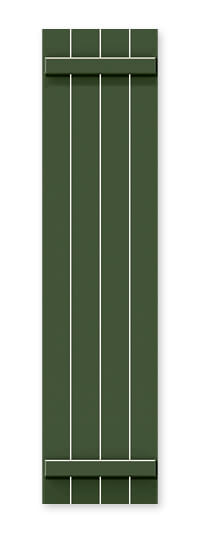
Timberlane.com
One of the simplest and oldest designs is the board & batten shutter. This style is simply vertical boards side by side held together held together by horizontal battens.
The most common style is to have three to four battens spaced evenly across the boards or have a top and bottom batten with a diagonal batten connecting the corner that form a “Z” pattern.
Board & batten shutters were most common on Mediterranean and Mission Style homes and to a lesser extent Ranch and French Country styles. These are a DIY friendly shutter that you can easily make for your home using the video below if you are handy.
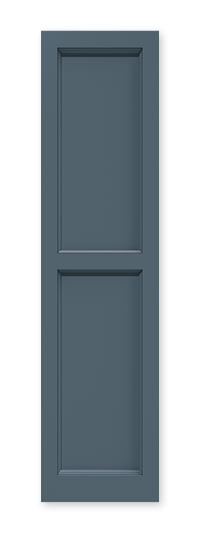
Timberlane.com
Flat Panel Shutters
Another simple style of shutter to make, the flat panel shutter is very similar in design to shaker style cabinets. They consist of a wood frame with recessed flat panel typically with between one and three panels per shutter.
Flat panel shutters fit nicely on the Colonial Revival, Greek Revival, Folk Victorian, Queen Anne, and Georgian & Adam style homes. These are more common on simpler architectural versions of the same homes where you would find raised panels shutters which we’ll discuss next.
Cutouts
Commonly found in flat panel shutters of Colonial Revival houses it was popular to customize their shutters with cutouts of simple images like a boat, tree, leaf, or some other whimsical design.
Typically these cutouts were placed on the top panel and really added an extra bit of character to what would be an otherwise plain shutter.
Today there are a multitude of cutout patterns available to fit almost any shape that would interest you.
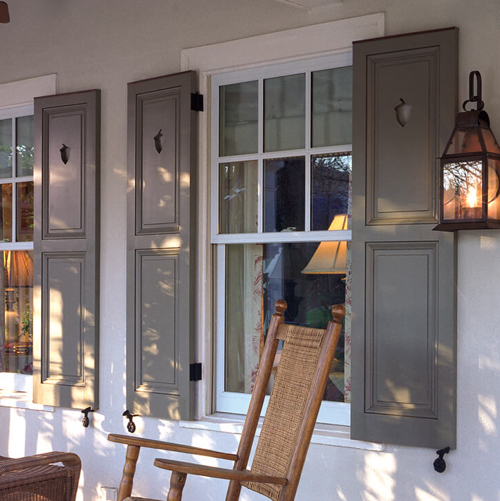
Timberlane.com
Raised Panel Shutters
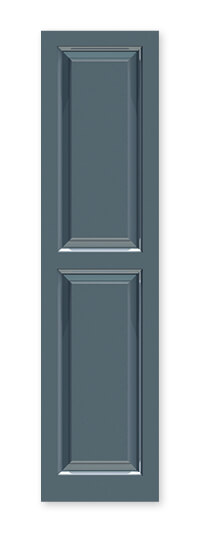
Timberlane.com
The upscale, fancy cousin of the flat panel shutter the raised panel shutter has been the ultimate in refinement and style for hundreds of years.
Typically found with between one and three panels these shutters are the mark of excellent woodworking abilities and craftsmanship so they belong on larger and higher end homes.
More expensive to make and with a variety of styles for the panel designs the raised panel shutter really dresses up high style homes in the Colonial Revival, Greek Revival, Folk Victorian, Queen Anne, and Georgian & Adam styles.
Bahama Shutters
Named for the islands off the coast of Florida, Bahama shutters (sometimes called Bermuda shutters) were popular for hundreds of years in the tropics for their regionally specific design.
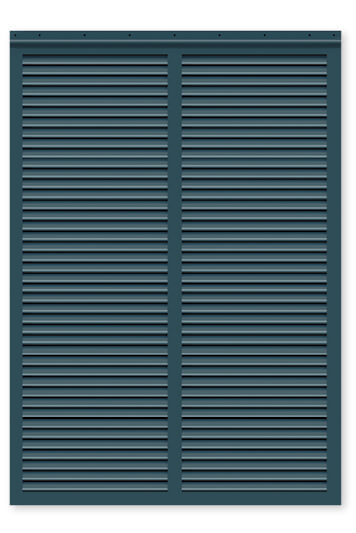
Timberlane.com
While most shutters are mounted on the side of the window and swing closed like a door Bahama shutters are mounted above the window and held propped open at a 45-degree angle to keep the heat of the day at bay.
Designed with louvers and usually a two-panel design the Bahama shutters acted like an awning during the hot day and could easily be closed from inside the building when a hurricane or other storm approached to protect the occupants.
While Bahama shutters can be installed on any style home they are historically installed on homes in the southern climates and tropical areas which means they will look out of place on most homes north of the Mason Dixon line.
Plantation Shutters
Essentially the same design as the operable louvered shutters we talked about earlier, plantation shutters are installed on the inside of the window rather than outside.
Plantation shutters allow for easy control of light and privacy inside a room. Often you’ll find full length plantation shutters covering the whole window, but just as often you’ll see half height plantation shutters that provide privacy and allow more light into the room.
Plantation shutters are also a big help when it comes to temperature control. When closed they block the hot summer sun or the cold air around your windows in the winter.
Using the operable louvers you can control the air flow to the windows as well. It’s recommended to keep the louvers facing up during the winter and facing down in the summer since hot air raises this helps regulate the room temperature.
Shutter Materials
Shutters are available in a lot of different materials today some of which are quite honestly a terrible mistake and others give that great historic shutter look.
Wood
The old standard are wood shutters, and there is still nothing that looks quite as good. There is a reason manufacturers bend over backwards to make their composite or vinyl shutters look like wood. After all no one tries to make their wood shutters look like plastic, right?
If you decide to go with wood shutters be sure to pay the extra to use a rot-resistant wood that will keep your shutters lasting a long time. Wood shutters are the easiest to repair of any shutter material, so while they may develop issues down the road they can be fixed by homeowners rather than having to pay for a replacement.
Composite
Composite gives a look very similar to wood without the potential for rot which is a nice benefit. The appearance of composite products compared to wood varies greatly so make sure you see a sample in person rather than just in a catalogue before deciding to go this route.
Another thing to think about with composite shutters is what the warranty is. Wood, while it may have issues with rot in wet climates, has been around for millennia and is very predictable and easy to repair if there is damage.
Many composites are still relatively new and untested so it’s important to know their track record before you buy. Composite is also not as easily repaired as wood.
Plastic
Vinyl, PVC, and other materials are all over the market for shutters as well and many manufacturers make quality plastic shutters whereas others make cheap flimsy versions that will melt in hot conditions.
While you will never have to worry about rot with plastics you want to check if the material is paintable should you ever decide to change the color in the future. Also, know that if you are relying on your shutters to protect your windows from storms, plastic is not nearly as strong as wood shutters and has a tendency to get brittle with prolonged exposure to UV.
Plastic shutters are the cheapest of shutters in most cases.
Shutter Hardware
Shutter hardware is a wondrously complex topic that I’ll only cover briefly here since there are so many options. There are a few main pieces that every working shutter needs so I figured that rather going into the 40 different style hinges we could cover these items to give you a sense of what you’ll need to look for when buying shutters.
Hinges
Every good operable shutter needs hinges and there are plethora of hinge options to choose from. There are strap hinges, Lull & Porter hinges, Clark Tip Blind hinges, New York style hinges, and Connecticut style hinges just to name a few.
When picking the right hinge you want to take into consideration the size and weight of your shutter as well as the design. so you can have a hinge that is both functional and attractive.
Deeper set windows may need a hinge with an offset to allow the shutter to fit into the deep window opening whereas flush set windows may need no offset at all.
Pintel
Usually a pintel is paired with a hinge to connect the shutter to the building. Where the hinge hold the shutter, the pintel hold the hinge to the building.
Different style pintels work with different style hinges so make sure they are a matched pair. Also, keep in mind what you are installing the pintel onto. Do you have a stone or brick building or wood trim where the pintel will be located. This decides what style of mounting hardware and sometimes even the design of the pintel needed.
Tiebacks
You need something to keep your shutters from blowing around when in the open position and that’s where a tieback comes in. Some times called “shutter dogs” these attach to the building usually toward the bottom of the shutter and hold it against the wall of the building securely until you are ready to close you shutters.
Locks
Just like the tieback hold your shutter in place when open the shutter lock holds the shutter in place when you have it closed. You can choose options as simple as a hook and eye or a variety of different slide bolts that secure the shutter from the inside or outside depending on what you prefer.
How to Size Shutters Properly
This is the topic that gets me all hot and bothered on Instagram. Shutters have certain sizing requirements because, after all, shutters were designed to work in tandem with your window.
If you have shutters installed that can’t cover your window when closed there is a good chance you will get featured on my weekly shutter shaming posts.
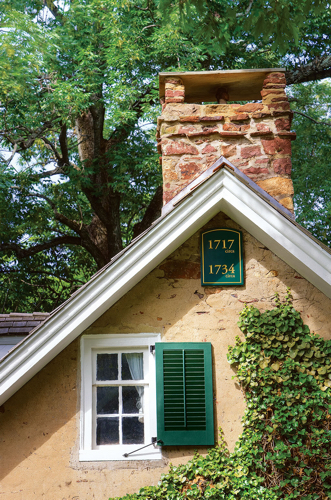
Timberlane.com
The simple fact is “real shutters shut” and you can’t avoid it. It’s in their name! If you decide you want shutters installed on your house then sizing them is extremely important.
The basic rule, with few exceptions, is that shutters should be the same height of the window and half the width. That way you’ll have two shutters in the closed position fit nicely into the window well.
There are occasions when a single shutter will be used to cover a window and this is absolutely fine. That shutter should then be the same dimensions of the window so that, again, when closed it will cover the entire window.
It sounds simple but so many people miss this as you can see from the pictures below.
I hope this post has helped give you some of the basics about wood shutters and helped you understand them a bit more. They are a beautiful accessory to add to almost any house if done properly. Just measure right and pick the appropriate style and you’re ready to get your shutter on.

Founder & Editor-in-Chief
I love old houses, working with my hands, and teaching others the excitment of doing it yourself! Everything is teachable if you only give it the chance.

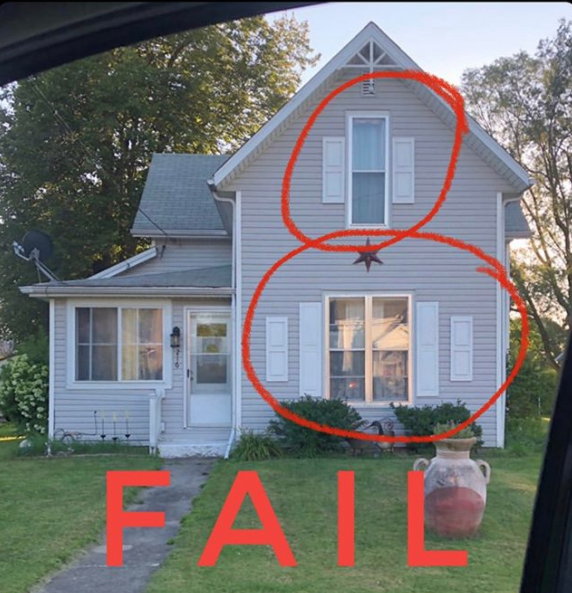
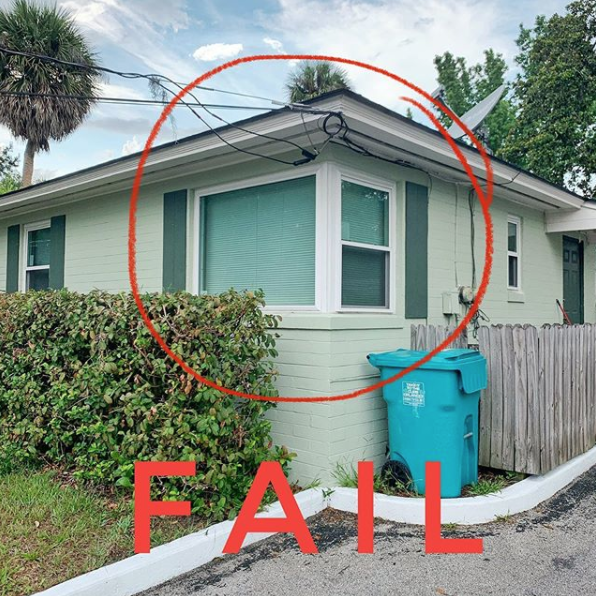
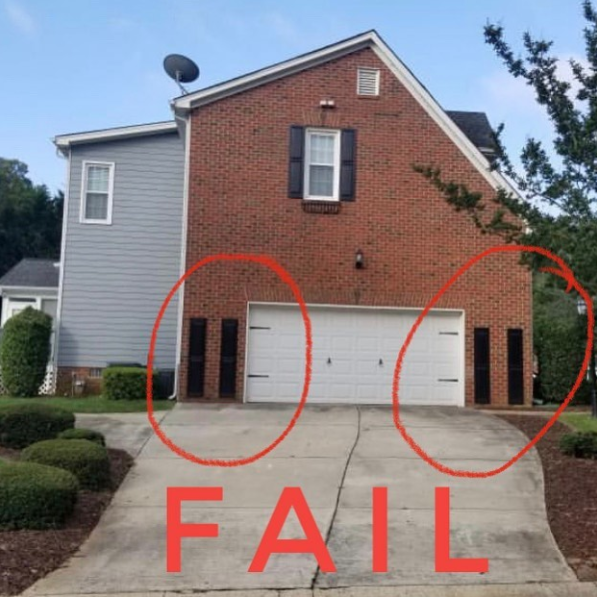
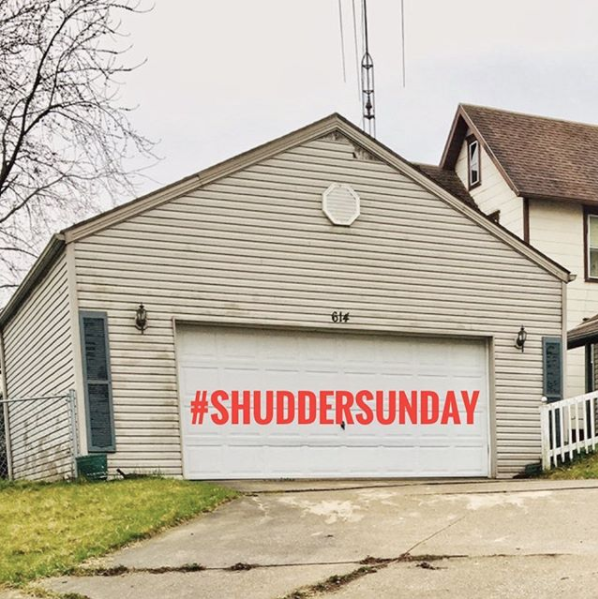

Thank you so much for your blog! It’s such a great resource. A question related to shutters: we’re trying to restore the shutters of our 1910 arts & crafts home, which has some colonial revival elements, like louvered shutters. A prior owner nailed them to the house, and we’ve been working to understand what type of tiebacks may have originally been used as we seek to correct this issue. There’s a metal arm (sorry for my lack of technical knowledge) on one of them that looks similar to the one in caption on the photo, “A single shutter sized properly.” There are also small drill holes in the cedar siding diagonally below most of the shutters where something may have been anchored — a shutter dog? Not sure if you’re planning a future article about shutter hardware, but it would be a terrific, instructive follow-up blog post. Thanks again.
Lisa,
Thank you for your questions. Please take a look at Scott’s Patreon Page https://www.patreon.com/thecraftsmanblog. You can choose from a membership that suits your needs to gain access to answers to questions related to your specific projects.
The Craftsman Blog Team
Could you write about impact rating and hurricane rating too?
Can the wooded shutters be used to protect from 180 mph flying debris, or they need to made of thick metal?
Thank you so much for your tips on how to shop for wooden shutters to keep them safe and well-maintained. I’ve always wanted to bring a more natural and comfy look to my house using wooden materials as much as possible, but I wasn’t so sure if I was ready to handle the maintenance that would come with it. These tips will definitely help alleviate some of that worry, so I’ll keep them in mind when I start looking for a place that sells wooden plantation shutters for me to decorate our house with.
What should one do with wider windows and narrower walls? Should they fold in a double layer? I’d like to make some for my back windows in case of hurricanes (we don’t have many here in E TN). Presumably I put them on the outside of the storm windows. Years ago someone put aluminum siding over the wood so shutters would have to sit on top of everything.
The front of our 1920s “hobbit house” has non functioning shutters that I need to change too. I have photos but couldn’t make links work.
Hi Scott, do you have any posts on inoperable shutters? You know, those that are just fastened to your house and don’t really shut. My windows are the vinyl style and the framing is only 1″ so I can’t really attach a real shutter that works. I’m contemplating attaching my 5/8″ home made cedar board and batten shutters actually thru the batten on all 3 boards with a black screw in each, top and bottom battens, so it will give a decorative look against the white battens. So, I will have to screw thru 5/8″ board + 5/8″ batten. I got a 3″ inch screw but it seems too long. Also, I do not want the screw to countersink, which happens so easily with cedar. Maybe screw by hand for the last few turns? Help!
Perfect timing tp read. Yesterday I googled images of shutters. My 1952 ranch apparently had board and batten shutters at one point. Emerald green. I found a pair in the garage attic with some of the old window screens. Sometime in the 60s the house was expanded and fully bricked in pumpkin pie color. Last week I started lime washing it, going for 4+ coats for solid white. Huge improvement. At 115′ long, there are two 6′, 20-pane, fixed windows that I’d skip, but four 6′ do6uble, double hung that I might add shutters. Have you ever seen board and batten shutters that fold on themselves? I haven’t. I can deal with 18″ exposure, but not 36″. I don’t have the skill or resources for louvered or paneled, but I can make and install b and b. Thanks.